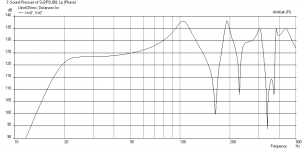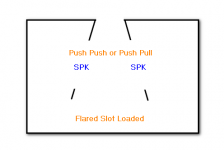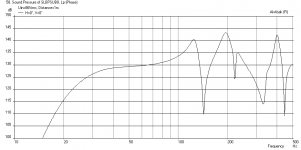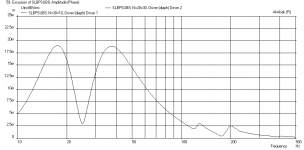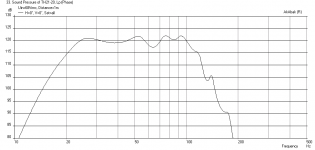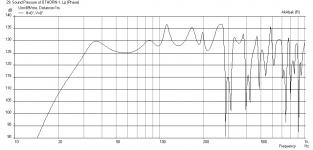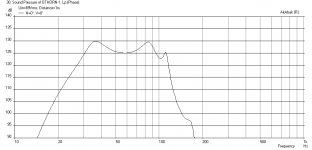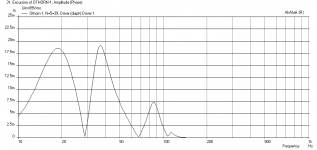18N860 is the driver of choice here, use it in the sims. I already have them and they are very good drivers and quite allrounders also. Just have to find the best solution for them.
CLS may be right, horn design in such limited space might not be the way to go to get both the extension AND sensitivity. I quess the PPSL is a better option, also easier to construct and less risky. I have read some say PPSL sounds like a servo sub (and also better than a TH), but I have never one myself.
Here's the next iteration of PPSL. With detachable slot portion one could alter between closed PPSL and reflex/bandpass PPSL just by detaching one slot and attaching another. The slot would be attached with for example M6 bolts from the front.

The slot could be approx. 22cm x 50cm with 2 x BMS 18N860. This would result in compression ratio pretty close to 2:1.
In reflex situation the slot/vent could be ~90cm deep. The inner volume of the box would be around 430 litres and the 22x50cm vent's area corresponds to around 38,5cm dia round vent, and thus the tuning freq should be around 28Hz. However the tuning point should be around 20Hz to my liking (Also woofer's Fs is around 22Hz). I have to think more about the venting. Maybe the vent could be tapered at the start to lower the tuning point, but I don't know how to simulate this kind of vent.
How do these two different setups of the same box differ in advanced sims like Akabak, could you xrk971 sim them?
CLS may be right, horn design in such limited space might not be the way to go to get both the extension AND sensitivity. I quess the PPSL is a better option, also easier to construct and less risky. I have read some say PPSL sounds like a servo sub (and also better than a TH), but I have never one myself.
Here's the next iteration of PPSL. With detachable slot portion one could alter between closed PPSL and reflex/bandpass PPSL just by detaching one slot and attaching another. The slot would be attached with for example M6 bolts from the front.

The slot could be approx. 22cm x 50cm with 2 x BMS 18N860. This would result in compression ratio pretty close to 2:1.
In reflex situation the slot/vent could be ~90cm deep. The inner volume of the box would be around 430 litres and the 22x50cm vent's area corresponds to around 38,5cm dia round vent, and thus the tuning freq should be around 28Hz. However the tuning point should be around 20Hz to my liking (Also woofer's Fs is around 22Hz). I have to think more about the venting. Maybe the vent could be tapered at the start to lower the tuning point, but I don't know how to simulate this kind of vent.
How do these two different setups of the same box differ in advanced sims like Akabak, could you xrk971 sim them?
Last edited:
Legis,
I suggested the PP slot loaded band pass reflex sub earlier and I think you said you thought that was risky. Then I provided a true 20Hz to 100 Hz TH sub and you say this may be risky. The truth is, neither are risky as the sims have proven themselves to be quite accurate in my experience. I have designed and built both, and each time the build measures close to the sim in terms of bass extension, SPL and upper cutoff. There is some work to be able to fold the TH from a straight design to fit in the box but my preliminary sketch shows that should be possible to fit in a 1 meter square footprint. I use a handsketch and a piece of string to estimate the total path based on the sketch which contains the final expansion ratio and location of major turns. Again, my experience in folding a TH is that it is doable as long as you ensure the profile of CSA vs length along horn propagation distance is accurate to the one used in the model.
Anyhow, if your preference is PPSL, we can go with that and use your driver of choice. It should not be hard as I have a skeleton of the model I did for CLS already from this thread:http://www.diyaudio.com/forums/subwoofers/255959-sim-slbp_pp-maybe-more.html It is easy to add or remove the final expansion from the slot to the front baffle. We can try both...
The only way you are going to get the 21Hz tuning is to extend that vent and to do so will require wrapping it around the interior of the box as shown schematically here:
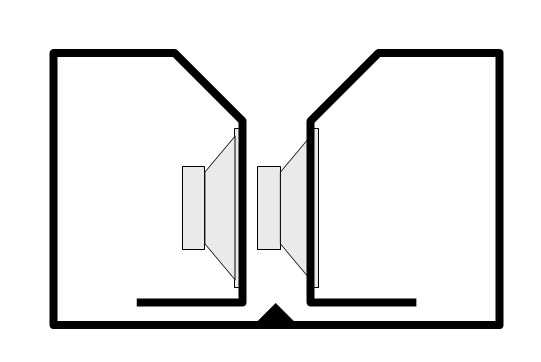
In practice, this is not hard to do and gives the box additional inherent bracing. Let me take a crack at it but you can feel confident that the model will be pretty accurate to the build on this.
Cheers,
X
Edit: starting to look at design now and BMS 18N860 has a depth of 250 mm and a bezel thickness of about 20 mm so the slot will at minimum, have to be 270 mm wide in order to have room to slide the driver in for installation and removal. Otherwise you will have to do as it you say with a removable slot module that holds the drivers and allows for swapping out closed vs vented. That however is hard to do with a wrap-around vent. I propose making it non removable at 300 mm wide for margin and have just a removable cap you can slip in and seal the vent for closed box operation.
I suggested the PP slot loaded band pass reflex sub earlier and I think you said you thought that was risky. Then I provided a true 20Hz to 100 Hz TH sub and you say this may be risky. The truth is, neither are risky as the sims have proven themselves to be quite accurate in my experience. I have designed and built both, and each time the build measures close to the sim in terms of bass extension, SPL and upper cutoff. There is some work to be able to fold the TH from a straight design to fit in the box but my preliminary sketch shows that should be possible to fit in a 1 meter square footprint. I use a handsketch and a piece of string to estimate the total path based on the sketch which contains the final expansion ratio and location of major turns. Again, my experience in folding a TH is that it is doable as long as you ensure the profile of CSA vs length along horn propagation distance is accurate to the one used in the model.
Anyhow, if your preference is PPSL, we can go with that and use your driver of choice. It should not be hard as I have a skeleton of the model I did for CLS already from this thread:http://www.diyaudio.com/forums/subwoofers/255959-sim-slbp_pp-maybe-more.html It is easy to add or remove the final expansion from the slot to the front baffle. We can try both...
The only way you are going to get the 21Hz tuning is to extend that vent and to do so will require wrapping it around the interior of the box as shown schematically here:

In practice, this is not hard to do and gives the box additional inherent bracing. Let me take a crack at it but you can feel confident that the model will be pretty accurate to the build on this.
Cheers,
X
Edit: starting to look at design now and BMS 18N860 has a depth of 250 mm and a bezel thickness of about 20 mm so the slot will at minimum, have to be 270 mm wide in order to have room to slide the driver in for installation and removal. Otherwise you will have to do as it you say with a removable slot module that holds the drivers and allows for swapping out closed vs vented. That however is hard to do with a wrap-around vent. I propose making it non removable at 300 mm wide for margin and have just a removable cap you can slip in and seal the vent for closed box operation.
Last edited:
Edit: starting to look at design now and BMS 18N860 has a depth of 250 mm and a bezel thickness of about 20 mm so the slot will at minimum, have to be 270 mm wide in order to have room to slide the driver in for installation and removal. Otherwise you will have to do as it you say with a removable slot module that holds the drivers and allows for swapping out closed vs vented. That however is hard to do with a wrap-around vent. I propose making it non removable at 300 mm wide for margin and have just a removable cap you can slip in and seal the vent for closed box operation.
Hi, I'm sorry to sound a bit doubtful.😀 I trust the sims to be quite accurate, but it's the general sound quality of TH that is not known to me (never heard one), especially if the response is a bit ragged near the upper end off the intended band. Raggedness might cause some hanging notes, which might make the integration to midbass trickier, or make the 60Hz-100Hz band offensive in general that I may on may not be able to live with. Due to lack of experience I may also imagine things and needlessly prepare for the worst.😀
I have also though of making removable top wall or back wall to make testing and driver mounting easier. Lossy coupling of mentioned wall to rest of the body would also break some of the box's bell modes et cetera. I have to think about that some more, too.
Hi, I'm sorry to sound a bit doubtful.
No worries, but you can ask around and many will say that the TH sub has the best sound quality if not asked to go too deep. For PA apps of 30 to 40 Hz its upper cutoff is above the XO. When asked to go to 20 Hz, the second octave range is in the 80 Hz range below the XO.
For the PPSL sub, if you account for the wall thickness of 18mm ply, the volume that the vent and slot duct consumes, in a 1 meter square exterior x 0.64 m high box, the effective volume is only about 240 liters. 400 liters gives you the ideal volume for deep bass extension. So, are you really constrained by a 1 m x 1 m x 0.64 m high box? If so, the PPSL sub will do 30 Hz easily but -3dB point is 24 Hz. With 400 liters the -3dB point is about 19 Hz.
The design I came up with if you allow for the 400 liter box gives this:
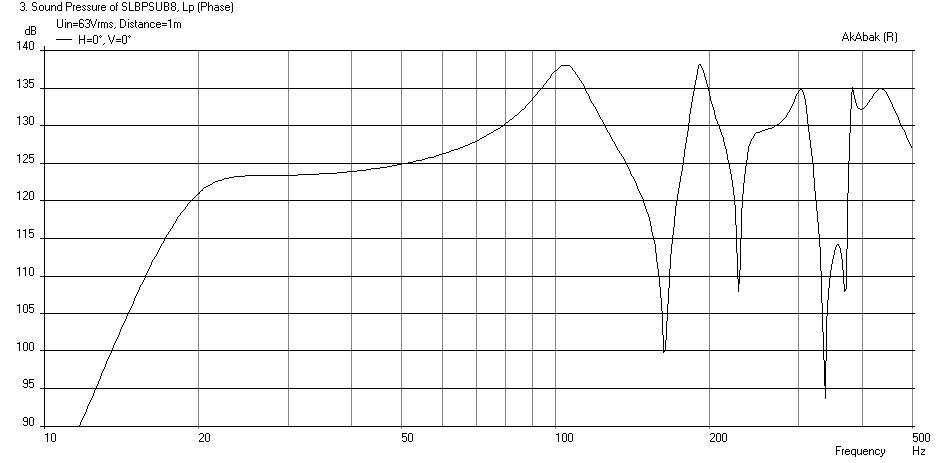
You will have to use EQ to reduce the peaking near 100 Hz but that is good as it lowers distortion. Let me work on it some more as I think the peaking is a function of the default slot length which I assumed to be the depth of the box minus the vent and ply wall thickness so it imposed a peak. I need to make the slot only as long as needed (20 inches) and peak should be pushed up much higher for flatter response.
Attachments
Last edited:
For the PPSL sub, if you account for the wall thickness of 18mm ply, the volume that the vent and slot duct consumes, in a 1 meter square exterior x 0.64 m high box, the effective volume is only about 240 liters. 400 liters gives you the ideal volume for deep bass extension. So, are you really constrained by a 1 m x 1 m x 0.64 m high box? If so, the PPSL sub will do 30 Hz easily but -3dB point is 24 Hz. With 400 liters the -3dB point is about 19 Hz.
Sounds like quite big volume for the vents and the slot! Also quite a resonance in the simulation due to long slot lenght. I wonder if flipped woofer will make that low freq resonance (almost) to disapper or not.
Hmm, maybe some kind of PPTH would be possible with with 2 x 18N860, that would only go to 30-40Hz (but still has ok capacity, like ~110dB in 1pi, at 20Hz) and would go to 100Hz with linear response without resonances. This kind of PPTH would do just fine for me. I could live with average capacity at 20Hz, comparable to that of closed box or even somewhat smaller than that. The speaker does not have to output straight line to 20Hz neither. The roll off can start sooner like with closed box. The room usually does the rest, and if not, then eq.
Last edited:
Reduced slot length PPSL
I made the slot as physically short as possible to still allow the driver to be mounted inside (47 cm deep). Retuned the vents which are now 5 cm deep x 57.4 cm high x 90 cm long (qnty2). The height corresponds to a 64 cm tall box with 18 mm ply tops and bottoms and qnty 2x 18 mm braces in the vents. The box volume is now 215 liters total which accounts for the volume taken up by one driver (assumed to be 15 liters) and the vents and the slot duct. The design generates 116 dB at 20 Hz which begins to falloff at about 40 Hz. So with EQ'ing you can get a flat response or let room gain bring it up. The shortening of the slot to 47 cm moved the 95 Hz peak over to 125 Hz.
Here is the frequency response with a 19.5 Hz -24dB/oct HPF driven to xmax at 86 volts:
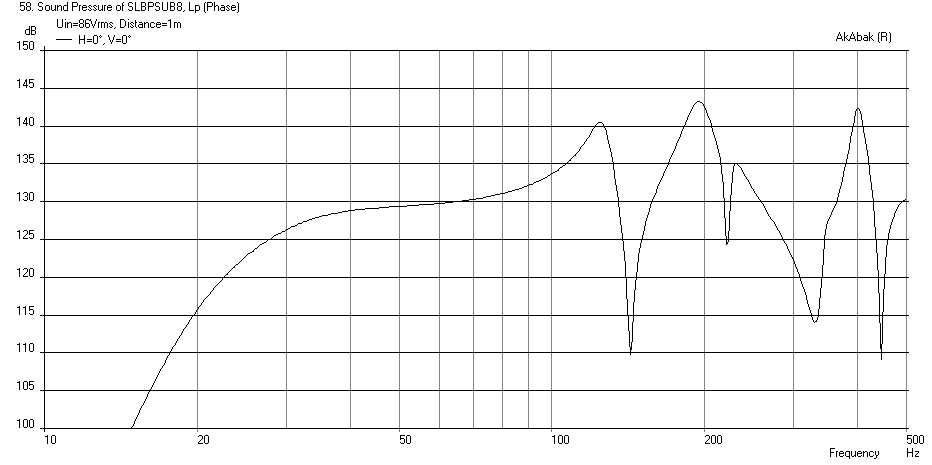
Here is the corresponding cone displacement at 86 volts (although you probably don't want to put that much power into them - but they can handle it as they are rated for 1.5kW ea) :
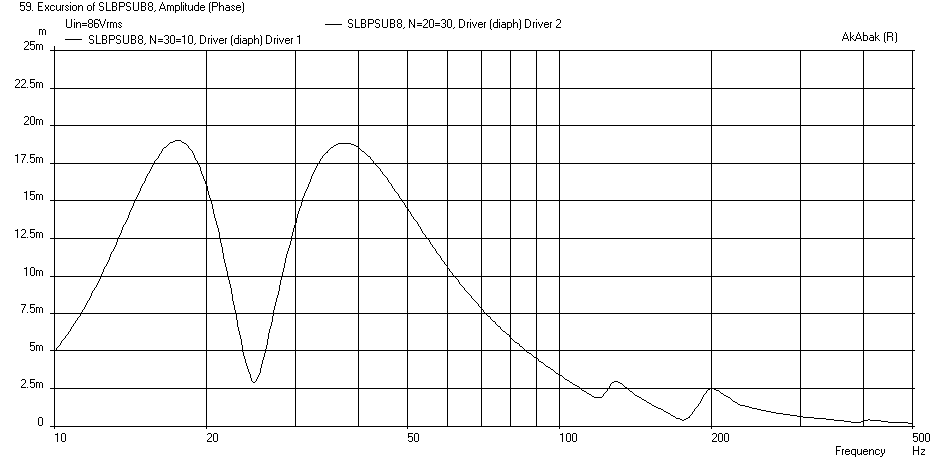
Here are the velocities in the vents and slot which is around 10 m/s max for minimal chuffing:
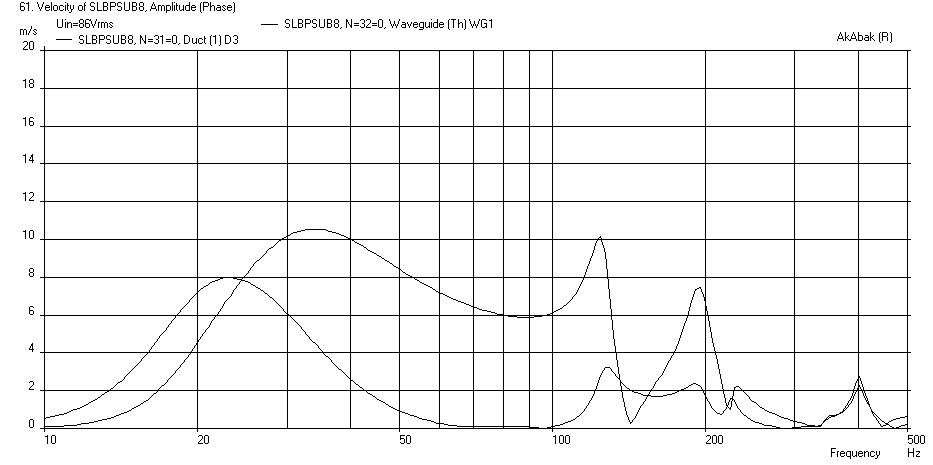
I made the slot as physically short as possible to still allow the driver to be mounted inside (47 cm deep). Retuned the vents which are now 5 cm deep x 57.4 cm high x 90 cm long (qnty2). The height corresponds to a 64 cm tall box with 18 mm ply tops and bottoms and qnty 2x 18 mm braces in the vents. The box volume is now 215 liters total which accounts for the volume taken up by one driver (assumed to be 15 liters) and the vents and the slot duct. The design generates 116 dB at 20 Hz which begins to falloff at about 40 Hz. So with EQ'ing you can get a flat response or let room gain bring it up. The shortening of the slot to 47 cm moved the 95 Hz peak over to 125 Hz.
Here is the frequency response with a 19.5 Hz -24dB/oct HPF driven to xmax at 86 volts:

Here is the corresponding cone displacement at 86 volts (although you probably don't want to put that much power into them - but they can handle it as they are rated for 1.5kW ea) :

Here are the velocities in the vents and slot which is around 10 m/s max for minimal chuffing:

Attachments
Last edited:
How would the BMS 18N862 work in this design?
Frode
Here is the same TH design with the 18N862 and a 20 in wide speaker driven at xmax of 19mm:
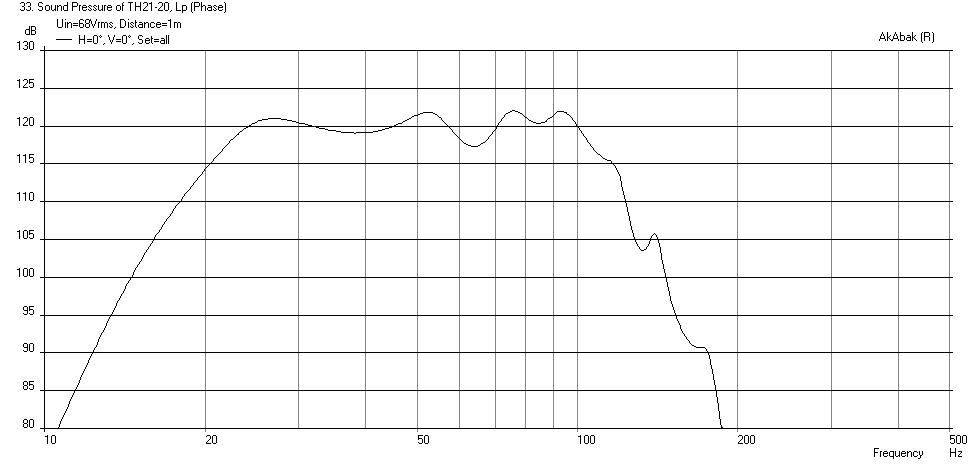
Attachments
Hi, i'm following 🙂 & wonder if this "might" be a solution to enable a lower fb?
This might have effect by constricting the vent but can't get drivers in through slot opening.
Here is the same TH design with the 18N862 and a 20 in wide speaker driven at xmax of 19mm:

Very nice! I have 4 BMS 18N862 that I plan to use below my Danley SH50s, and a TH is absolutely a candidate.
Frode
Very nice! I have 4 BMS 18N862 that I plan to use below my Danley SH50s, and a TH is absolutely a candidate.
Frode
How low do you need it to go because increasing to 30 vs 20 Hz before falling off makes a big difference. You might look at Othorn as Neodan suggested. I could stick this driver into a 20 in wide Othorn and see how it does... But the BMS 18n862 is certainly a candidate for a TH (or any other horn loaded alignment).
How low do you need it to go because increasing to 30 vs 20 Hz before falling off makes a big difference. You might look at Othorn as Neodan suggested. I could stick this driver into a 20 in wide Othorn and see how it does... But the BMS 18n862 is certainly a candidate for a TH (or any other horn loaded alignment).
I'm not sure. It's for music in a living room, not HT or professional use. I've never had a sub before, but I guess 30Hz would work well with music. Please simulate the Othorn with my BMS.
Frode
I could stick this driver into a 20 in wide Othorn and see how it does....
How would narrowing the Othorn affect the performance? Would it be better to keep the original width?
Frode
You narrow it to keep the characteristic volume of the enclosure commensurate with a smaller driver - but wait, I think I was mistaken and the Othorn is already designed for a 18 in driver. In that case keep it the same but that is one parameters that can be tweaked. One thing about the 18N862 is that the cone is exceptionally light and thin for something this size - not sure if this is the best for a high pressure tapped horn. Although it is light they use carbon fiber to reinforce it so probably works fine.
Edit: just looked at Othorn script it is indeed for a 21 in driver so scaling would make sense.
Edit: just looked at Othorn script it is indeed for a 21 in driver so scaling would make sense.
Last edited:
Hmm... 18N862 is actually not that light and thin as you might think.
277g of Mms for 18" is moderate. And the cone is very deep, which adds to the overall rigidity. I think it's no problem in taking some pressure.
Mms of my Eminence SigmaPro 18 and the EV DL18W I used in the big FLH are both 130g or so, but they are not the lightest, yet.
-----
Back to the project, one last thought. If the goal is 20Hz within the restriction of size (and the OB is ruled out), I'd suggest some cabinets with sealed chamber(s).
The reason is better protection to the drivers when they're facing very low frequency and very high SPL, especially when EQ'ed.
(and personally, except OB, I like the sound of sealed more than vented)
So it can be designed as a 25-30Hz system, and doing 20Hz (or even lower) with EQ when needed.
When playing at very high SPL, 40-50Hz is already very powerful and physical, I don't think it's a 'requirement' to get down to 20Hz at such moment. Digital EQ provides dynamic limiter for such application.
277g of Mms for 18" is moderate. And the cone is very deep, which adds to the overall rigidity. I think it's no problem in taking some pressure.
Mms of my Eminence SigmaPro 18 and the EV DL18W I used in the big FLH are both 130g or so, but they are not the lightest, yet.
-----
Back to the project, one last thought. If the goal is 20Hz within the restriction of size (and the OB is ruled out), I'd suggest some cabinets with sealed chamber(s).
The reason is better protection to the drivers when they're facing very low frequency and very high SPL, especially when EQ'ed.
(and personally, except OB, I like the sound of sealed more than vented)
So it can be designed as a 25-30Hz system, and doing 20Hz (or even lower) with EQ when needed.
When playing at very high SPL, 40-50Hz is already very powerful and physical, I don't think it's a 'requirement' to get down to 20Hz at such moment. Digital EQ provides dynamic limiter for such application.
How would narrowing the Othorn affect the performance? Would it be better to keep the original width?
Frode
Here is the sim of the Othorn (script from AVS Forums) that I modified to allow scaling of the CSA of the waveguides. This let me apply a scaling of 19.5/22.5=0.867 to give the driver clearance similar to the original 21 inch driver. It is not as flat as the original 21 inch, but then it is not bad either and has 30 Hz reach with unspeakable SPL capability at 19 mm of xmax which requires 89 volts to reach with a 20 Hz -24dB/oct HPF. You could shake a house apart with this thing.
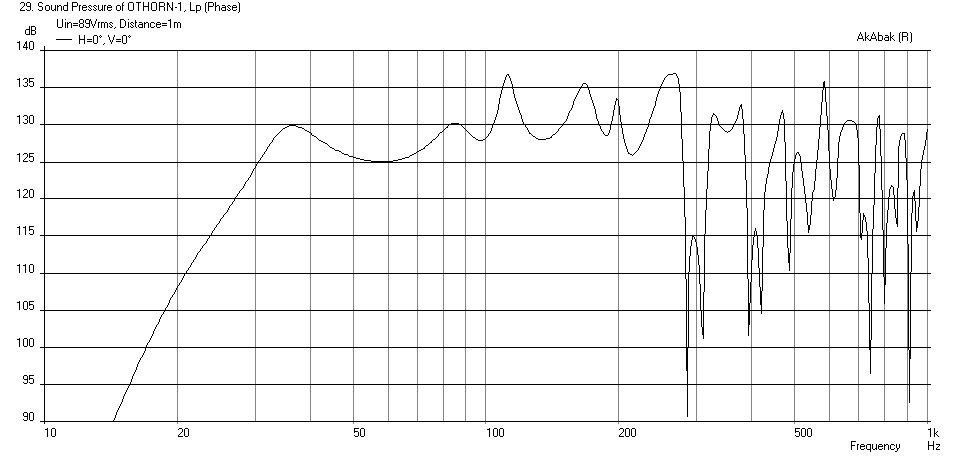
If you apply a -48dB at 95 Hz LPF you get this:

Here is the corresponding cone displacement at 89 volts drive:
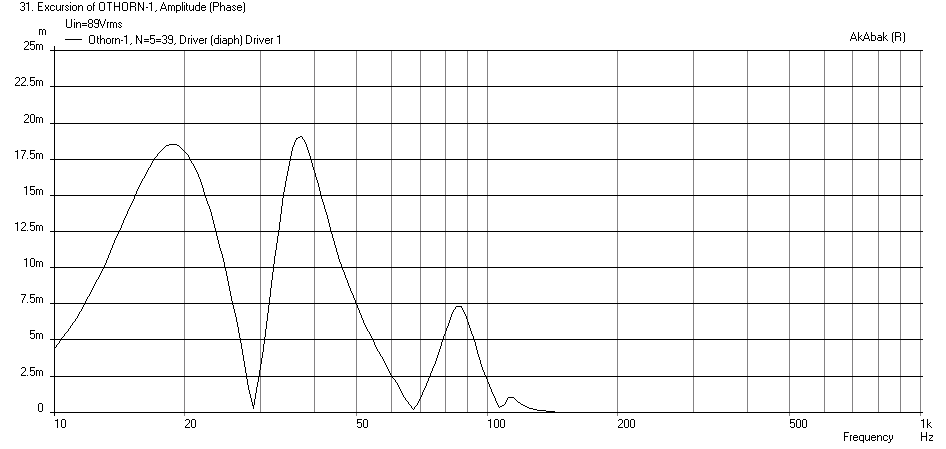
Attachments
Last edited:
Is that 2 per side for a total of 4?
Yes, total of 4. 🙂
For past two days I have been thinking of ~30Hz PPTH for them (~2,85m path lenght). I haven't found the best folding yet though.
I have also been thinking of slight stuffing and some strategic absorbent mat placement to reduce the resonances above the pass band.
TH for a pair of 18" would be very large, no?
2,85m path lenght would fit in 100cm x 100cm footprint. The previous simulation I posted (click) had the needed path lenght, little over than that actually. Even though it was crude picture without correct measurements, I think I could be possible. However the folding should be made better than what it was to get better top end response.
- Status
- Not open for further replies.
- Home
- Loudspeakers
- Subwoofers
- Study of a Dipole/Cardioid Bass Horn
